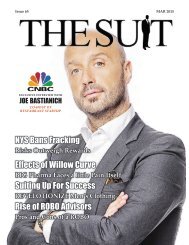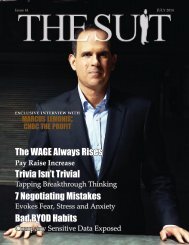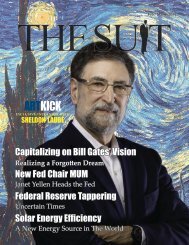One City Built to Last
The news is in: On November 7, 2014, the justices announced they would decide on a lawsuit claiming that the language of the Affordable Care Act doesn’t allow the government to provide tax-credits to low-and-moderate-income health insurance consumers using federally funded Obamacare exchanges operating in more than 30 states. Indeed, there’s a medical quagmire. And there is a lack of communication between doctors, staffing and patients. For example, the Affordable Care Act isn’t just about insurance coverage. The legislation is also about transforming the way health care is provided. In fact, it has brought in new competitors, services and business practices, which are in turn producing substantial industry shifts that affect all players along health care’s value chain. Read Amy Armstrongs story on page 16. On page 21, our reporter Judy Magness, profiles companies all over the country making incredible advances. Take a look at Functional Medicine and the driving breakthroughs in breast cancer while
The news is in: On November 7, 2014, the justices announced they would decide on a lawsuit claiming that the language of the Affordable Care Act doesn’t allow the government to provide tax-credits to low-and-moderate-income health insurance consumers using federally funded Obamacare exchanges operating in more than 30 states. Indeed, there’s a medical quagmire. And there is a lack of communication between doctors, staffing and patients. For example, the Affordable Care Act isn’t just about insurance coverage. The legislation is also about transforming the way health care is provided. In fact, it has brought in new competitors, services and business practices, which are in turn producing substantial industry shifts that affect all players along health care’s value chain. Read Amy Armstrongs story on page 16. On page 21, our reporter Judy Magness, profiles companies all over the country making incredible advances. Take a look at Functional Medicine and the driving breakthroughs in breast cancer while
You also want an ePaper? Increase the reach of your titles
YUMPU automatically turns print PDFs into web optimized ePapers that Google loves.
y mary minor davis<br />
Offsetting the Traditional<br />
“Four Percent Rule”<br />
Mike Philbrick, CIM®, AIFP®,<br />
Senior Vice President<br />
and Portfolio Manager<br />
To ensure that financial planning truly<br />
addresses <strong>to</strong>day’s retirement needs,<br />
some wealth managers are rethinking<br />
the traditional “4 percent rule” in favor of<br />
greater portfolio diversification <strong>to</strong> address<br />
how they can prepare for their clients’ longterm<br />
needs, given <strong>to</strong>day’s challenging market<br />
conditions.<br />
Mike Philbrick, CIM®, AIFP®, is a Senior<br />
Vice President and Portfolio Manager at Butler,<br />
Philbrick, Gordillo & Associates Group,<br />
an affiliate within Dundee Goodman’s Private<br />
Wealth division. He shared some thoughts<br />
with The Suit Magazine on his team’s approach<br />
<strong>to</strong> managing the contemporary retirement<br />
conundrum.<br />
The 4 percent rule was devised in the 1990s<br />
by California financial planner William Bengen<br />
and later refined by other retirement-planning<br />
academics. Bengen analyzed his<strong>to</strong>rical<br />
returns of s<strong>to</strong>cks and bonds, and found that<br />
portfolios with 60 percent of their holdings in<br />
large-company s<strong>to</strong>cks and 40 percent in intermediate-term<br />
U.S. bonds could sustain withdrawal<br />
rates starting at 4.15 percent, adjusted<br />
each year for inflation, for every 30-year span<br />
going back <strong>to</strong> 1926.<br />
However, Philbrick, in quoting from a recent<br />
article published by Wayde Pfau, a professor<br />
of retirement income at the American<br />
College for Financial Services, said there is<br />
strong evidence that the rule no longer applies<br />
in <strong>to</strong>day’s market conditions.<br />
For example, people with portfolios expecting<br />
<strong>to</strong> draw 4 percent in retirement forever<br />
with a high level of confidence – without<br />
regard for market regime – haven’t fac<strong>to</strong>red<br />
in that long-term rates are yielding his<strong>to</strong>rical<br />
low returns of between 2 1/2 <strong>to</strong> 3 percent. At<br />
the same time, the US s<strong>to</strong>ck market is near alltime<br />
high levels of valuation. . “When these<br />
two fac<strong>to</strong>rs co-exist, a financial plan that’s<br />
based on the well-accepted 4 percent rule<br />
has about a 57 percent failure rate,” Philbrick<br />
quoted from Pfau’s analysis.<br />
“What this means is, that if people are planning<br />
retirement using traditional portfolio<br />
management techniques, they may be go<br />
THE SUIT MAGAZINE - NOV 2014










